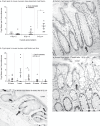Long-term mucosal injury and repair in a murine model of pelvic radiotherapy
- PMID: 31551503
- PMCID: PMC6760522
- DOI: 10.1038/s41598-019-50023-4
Long-term mucosal injury and repair in a murine model of pelvic radiotherapy
Abstract
Chronic intestinal injury after pelvic radiotherapy affects countless cancer survivors worldwide. A comprehensive understanding of the long-term injury dynamics is prevented in available animal models. With linear accelerators that are used to treat cancer in patients, we irradiated a small volume encompassing the colorectum in mice with four fractions of 8 Gy per fraction. We then determined the long-term dynamics of mucosal injury, repair, and the duration of inflammation. We show that crypt fission, not cell proliferation, is the main long-term mechanism for rescuing crypt density after irradiation, and provides a potentially wide window for clinical interventions. Persisting macrophage aggregations indicate a chronic mucosal inflammation. A better understanding as to how crypt fission is triggered and why it fails to repair fully the mucosa may help restore bowel health after pelvic radiotherapy. Moreover, anti-inflammatory interventions, even if implemented long after completed radiotherapy, could promote bowel health in pelvic cancer survivors.
Conflict of interest statement
The authors declare no competing interests.
Figures




References
Publication types
MeSH terms
LinkOut - more resources
Full Text Sources
Medical

